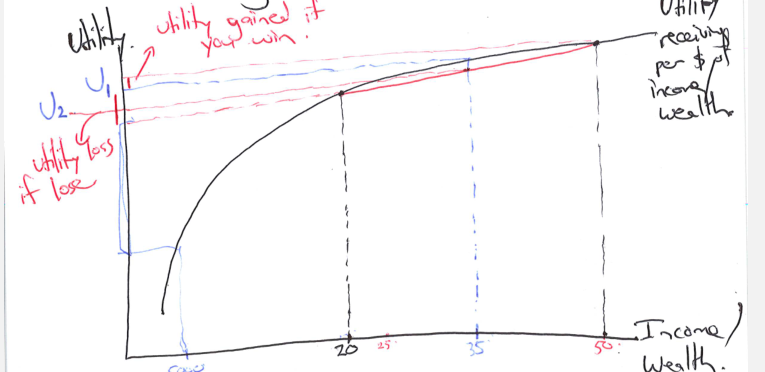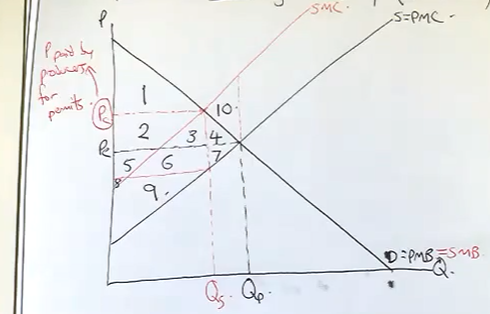Econ207 finals
1/68
There's no tags or description
Looks like no tags are added yet.
Name | Mastery | Learn | Test | Matching | Spaced |
|---|
No study sessions yet.
69 Terms
risk aversion
tendency to refuse fair gamble because a loss will decrease utility more than a gain increases utility.
fair gamble
a gamble where the expected value is zero, an equal chance of winning and losing.
expected value formula
p1 × x1 + p2 × x2
expected value
average outcome for a game
how to find the utility given from a gamble
find the expected payout, the average payout of the gamble, and calculate the utility from there
finding the utility on a graph
straight line between the two possibilities, where it cuts the expected value is the utility

Asymetric information
one party has an information advantage, they know things the other doesn’t
Adverse selection
underinformed party enters a deal that favors the informed party, without the knowledge of the underinformed party
Moral hazard
one of the parties changes behaviour as a result of entering a contract
a person speeding because they have their car insured is an example of what?
example of moral hazard
an insurance company entering into a contract with someone who is likely to die soon is
an example of adverse selection
a company not having info about the skill level of an employee is
an example of asymetric info.
flexiblity
prevents a decision from being tied to a single choice, as it can be adjusted based on the future
fair insurance
premium of the insurance is the same as the expected loss
what price is a person Willing to pay up to for insurance
until its equal to the utility of the expected income without insurance
searching cost
the cost to find information or a deal to make a transaction
transaction costs
costs incurred when a party sells something, such as searching, admin or advertising
pooling equilibrium
signals from a group are all similar, so they are all treated the same. the effort of employees is hard to tell, so they are all paid the same
seperating equilbrium
members of a group have different signals so they are treated differently. employees send signals of effort, and those who work harder are payed more.
why do firms exist
to reduce transaction and searching costs, improving effciency and allowing for more transactions to take place
what happens if transaction costs are too high
the transaction doesn’t get done and is avoided instead
naive signal
signal that costs the same to everyone
weak signal
inaccurate signal, different cost to different types
signals
conveys accurate information, different costs for different types
4 ways to reduce risk
insurance, diversifcation, information, flexibility
transaction costs
costs of a business deal, both finacial and non financial
General equilbrium
prices and quantites for multiple markets are decided at once
parital equilbrium
equilbrium for a single market is found and the other prices are taken as given
abatements
reductions to harmful externalities, and the incentives for doing so
command and control
using laws and standards to effect economic activity, over using market activity.
input tax
taxes on the harmful inputs used in making a good, creates incentive to decrease the harmful inputs
cap and trade
caps amounts of outputs at the socially beneficial quantity, and trades the permits for making outputs using harmful inputs.
pareto equilbrium
a point where no one actor can be made better off, without diminishing the outcome of another.
second welfare theorem
any particular parteo optimal outcome can be achieved by a lump sum redistrobution, and letting the market take over
first welfare theorem
market tends towards a pareto optimal outcome when it has perfect information, price taking behaviour, no externalities and non satiation
lump sum redistrobution
single payment to an effected party, eg benefits or settlements to iwi
how does the second welfare theorem suggest that inequalities should be addressed?
lump sum redistrobution to move the society to a pareto equilbrium that is more equal
framing effect
changing the choices of an actor, by reframing the same choice in 2 different ways
what does behavioral economics indicate about decision making
people will make ineffcient choices because biases, self control issues
what is discounting, behavioural economics
a bias that places greater value on things avalible now, rather than in the future
what are some examples of nudging
setting the preferred, rational option as the default, or adding a useless, inferior option to make another look better
how can classical models account for a persons concern for others
adding the utility of others into their utility curve.
what are the defining characteristics of public goods
non-excludable, non-rival
non-excludble
people can’t be stopped from using the good
non-rival
one person consuming the good doesn’t stop others from consuming the good, more than one person can benefit
for a public good, what does the p represent in a demand curve
represents the willingness to pay, given the benefit. they cant be made to pay because its non-excludble.
solving for p on a demand curve for a public good gives what?
the marginal benefit at the given quantity
how to find the marginal social benefit in the public good scenario
add the demand curves for all of the consumers, giving the total benefit
when finding the optimal quantity for public goods, what do you do when exceeding one of the consumers marginal benefit
ignore them and find the marginal benefit for the other consumer
when the permits for a cap and trade have to be paid for, what line do consumers produce along?
along the SMC curve, because its an extra cost above their private costs.

how does diversifcation decrease risk
reduces probablity of the largest possible losses by spreading risk over more options
why is the utility over income function curved
to show the diminishing marginal utility of income, as extra income from a dollar decreases as wealth increases
diffrerence between signalling and screening devices
signalling shows others what your qualities are, a screening device is applied to others to figure out what their qualities are.
what view did the māori have over land ownership
no one person held rights to the land, it was used for the benefit of the group.
what type of utility to income do you have if you are risk averse
diminsihing utility to income, less utility per dollar of income as income increases
fair premium
insurance premium is the same as expected loss * probablity of the loss or the amount you lose from inital wealth to expected wealth
What concept did Māori use instead of land ownership
Guardianship of the land and resource, being tanagata whenua, or people of the land
Māori worldview was based on connection to what?
based on connection to the land
what view did the Europeans have on land
people can have rights and ownership over the land, stemming from background of royalty owning everything.
was their ownership of land in the māori worldview
no, people had relationships and guardianship over the land
why may a government give away a cap and trade permit rather than charging
political reasons.
difference between input and output taxes on a graph
input shifts the supply line, showing higher costs, output doenst change supply line but limits where the supply is
how does a businesses climate and consumption graph differ to a persons
steeper to give more consumption and less enviromental quality, because the companies benefit from the greater consumption.
what is needed for the first welfare theorem to hold
Perfect information, price taking behaviour, non sasitanon and no externalities.
how did asymetric info effect the Māori land sales
Māori did not have information on the transaction costs
if someone is risk neutral, what are they only interested in
the expected value of the gamble